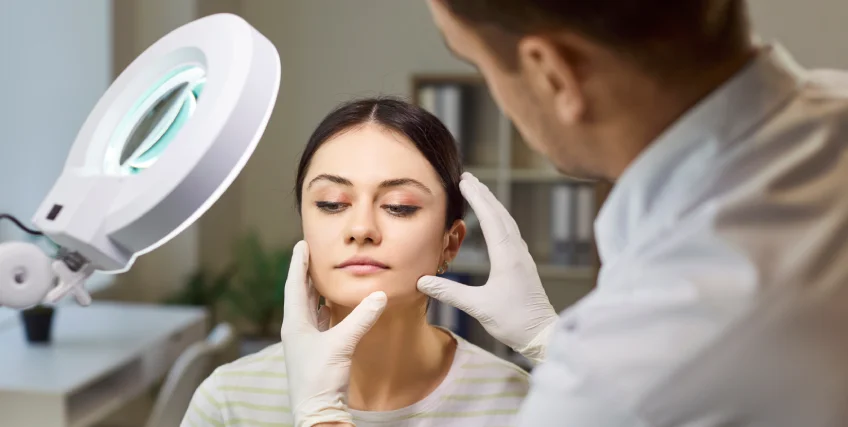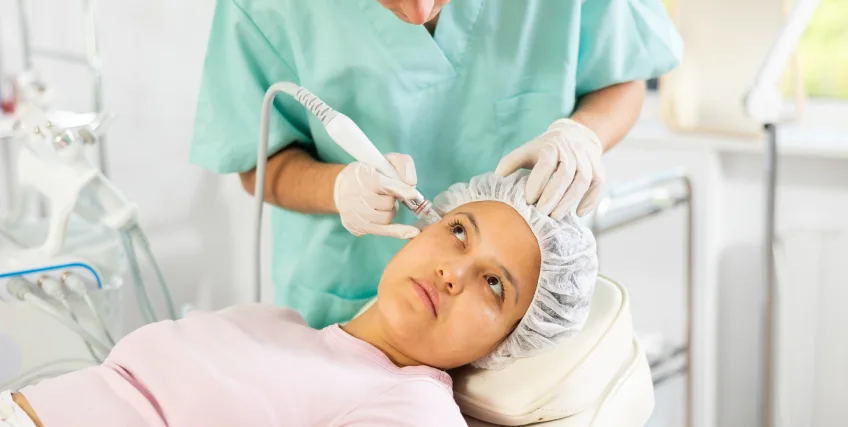Using Business Loans to Hire Staff and Upgrade Technology in Dermatology
August 14, 2025 | Last Updated on: August 14, 2025

The field of dermatology is highly rewarding and can be lucrative. But success doesn’t happen overnight. It will take a lot of hard work and good business sense to make your dermatology practice succeed.
You undoubtedly want to give your patients the best care by having a highly experienced team. Your practice also needs the latest technological innovations to stay competitive and meet client expectations. That’s where medical practice loans can be helpful.
In this article, we’ll explore:
- How hiring and technology investments can drive growth for your dermatology practice
- The startup cost for dermatology practices
- How a business loan can help at every stage of your business
- Frequently asked questions about medical practice loans
The dermatology industry is worth an estimated $9 billion in the United States. To earn your fair share of the market and have a successful practice, it’s essential to hire skilled staff and invest in modern technology. Great employees improve workflow and patient satisfaction, while advanced tools and technology help you deliver better care and stay competitive.
Medical practice loans can provide the funding you need to support this growth and expand your services.
How Business Loans for Healthcare Professionals Can Help
Building a successful dermatology practice requires more than clinical skills. It takes wise financial planning to thrive and succeed. Business loans designed specifically for medical professionals can provide the capital dermatologists need to open new offices, upgrade equipment, hire staff, or expand services.
Benefits of Medical Practice Loans
Business loans for healthcare professionals offer many advantages over standard business financing. Medical practice loans are often tailored to the cash flow patterns and stability of medical practices, making them a great fit for dermatologists.
The benefits of medical practice loans for dermatologists include:
- Fast Access to Capital: Some lenders, particularly online loan platforms, offer quick credit approvals and funding, allowing you to act fast when opportunities arise.
- Flexible Repayment Structures: Many physician practice loans have customized repayment schedules that align with your practice’s cash flow, making it easier to repay the loan.
- Preserving Cash Flow: You can use a medical practice loan to cover major expenses, like hiring, office space renovations, or new technology, without draining your working capital. This leaves you in a better financial position to cover operational expenses.
- Potentially More Favorable Repayment Terms: Because dermatology practices tend to have a high influx of patients and steady revenue throughout the year, it’s often easier to get healthcare practice financing at lower rates and with better loan terms than the average business loan. Of course, this depends on your credit and other factors.
But on average, it holds true.
Types of Medical Practice Loans
The following types of small business loans work for many industries. However, some lenders have several loan options tailored for healthcare professionals, including dermatologists.
Term Loans
With a term loan, a lender approves you for a lump sum and gives you all of the loan funds at once. Typically, you pay back the loan in fixed, monthly payments plus interest over a set period of time. Term loans can be short or long term, with repayments varying from three to 10 years, depending on the lender and what the funds are used for.
Loan funds from a term loan can be used toward almost anything, ranging from opening a new dermatologic office to purchasing inventory or equipment and more. Some lenders may require collateral, depending on their lending policies and your credit score and business financials.
Equipment Financing
A medical equipment loan can be highly beneficial for your dermatology practice, as the loan funds can be used to purchase expensive technology such as imaging systems, lasers, and treatment chairs. The equipment purchase with the funds is also collateral for the loan, so equipment financing is often easier to get than other medical practice loans.
Repayment for equipment financing is often similar to a term loan, where equal payments are spread out over time. Lenders usually set the repayment period to the useful lifespan of the equipment. So, if the equipment you purchase is expected to be utilized for five years, the repayment period will be five years or less.
SBA Loans for Healthcare Practices
SBA loans are backed by the Small Business Administration, which reduces risk for lenders, SBA loans often come with more favorable terms than traditional bank loans.
However, the underwriting and application process for SBA loans is much more exhaustive than other types of business loans.
Depending on the SBA lending product used, you may be able to use SBA funds for commercial real estate purchases, medical equipment, to open a second location, and even to refinance or consolidate business debt. The SBA 7a loan is the most common financing option used by most small business owners.
Other Types of Financing
Lines of Credit
A business line of credit operates similarly to a credit card. A lender approves you for a maximum credit limit, and you can borrow against the limit without having to use all of the limit at once. Then, you repay only the limit you’ve used plus interest, which can be fixed or variable.
Loan Application Tips for Dermatologists
Preparation is key when applying for medical practice loans. Here are some key points to consider for a strong loan application that leads to credit approval.
1. Create a Clear Business Plan
Lenders will want to see that you have a clear and realistic plan that will help your practice succeed. A business plan can provide the insight needed to help lenders feel more confident about loaning your practice money.
A business plan should outline your goals for your dermatology practice and explain how your practice will run (will you be the only dermatologist, or are you bringing on more practitioners). It should also detail how you plan to use the loan funds, whether to hire more staff, open another location, or upgrade equipment.
Your business plan should also include your practice’s monthly expenses and a projection of how much you think your practice will bring in.
2. Check Your Credit Score
Some lenders only look at a borrower’s personal credit score to determine eligibility, while others will look at the business credit score. Some will look at both. It’s a good idea to know where you stand with your credit scores because it can help you determine which type of lender to go with.
Request your credit reports from the major credit reporting bureaus, including TransUnion, Equifax, and Experian. You can get a free report once a year from AnnualCreditReport.com.
3. Choose the Right Lender
Knowing where your credit score lies can help you choose the right lender and avoid wasting time on the application process.
For example, banks typically require a high credit score, while online lenders may offer flexible financing solutions for dermatologists with credit scores in the mid-600s, as well as options for those with lower credit scores.
The higher the credit score, the greater the chance of a loan approval with better terms and lower interest rates.
Another thing to consider when choosing a lender is how fast you need capital. Banks and the SBA are notoriously slow in approving loans and disbursing loan funds.
Conclusion
Running a successful dermatology practice takes more than medical knowledge. It requires smart business decisions, too. Hiring skilled staff and investing in advanced technology are two of the best ways to improve patient care and grow your practice. But these upgrades often require a significant investment that’s not always readily available through your working capital.
This is where medical practice loans can make a big difference. Specialized healthcare practice loans can help you expand services by hiring more staff and acquiring the latest technology to stay competitive and offer the best care to your patients.
Whether you’re opening a new office, upgrading equipment, or bringing on new staff, a healthcare business loan gives you the tools to move forward with confidence. With good financial planning, the right lender, and a clear vision for growth, your dermatology practice can thrive for years to come.
FAQs About Medical Practice Loans
1. How high does my credit score need to be to qualify for medical practice loans?
This can vary by lender, the type of loan, and the loan amount. However, many traditional lenders prefer a borrower to have a credit score of 650 or more. However, alternative loan specialists online have flexible funding solutions for borrowers with lower credit scores.
2. What is the average startup cost for dermatology healthcare practices?
The average startup cost for dermatology practices alone is $150,000 to $300,000 just for licensing, equipment, and remodeling costs. Once you add payroll for staffing, supplies, branding and marketing costs, real estate and lease expenses, you could easily be looking at another $300,000 or more in operational costs for the first year.
3. Can I use a medical business loan to hire new employees?
Particularly, when a medical practice loan increases your capacity to serve more patients, which in turn, boosts revenue for your practice. SBA 7 loans and term loans through an online lender are great financing options for hiring new staff.
4. What kind of technology upgrades for my dermatology practice can I finance with a medical practice loan?
You can use a medical business loan to upgrade dermatology equipment like lasers, microneedling devices, and imaging systems. You can use your medical practice loan to invest in EMR software, teledermatology platforms, and practice management tools. Computer equipment and cybersecurity software can be financed as well.
5. How fast can I get approved for a healthcare practice loan?
Approval times for a medical practice loan will vary by lender. Traditional bank and SBA loans can take several weeks to even months. The exception to this is online lenders that use SBA software to expedite the loan process.
Frequent searches leading to this page
Term Loans are made by Itria Ventures LLC or Cross River Bank, Member FDIC. This is not a deposit product. California residents: Itria Ventures LLC is licensed by the Department of Financial Protection and Innovation. Loans are made or arranged pursuant to California Financing Law License # 60DBO-35839




